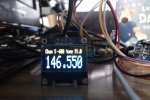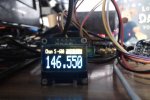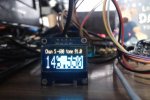C5 ad C6 are best added after the Arduino Nano is installed as they are pretty close to it. Note the polarity, otherwise smoke will come!
C5 -C7 are only installed if the Si5351 board SMA connectors are not used, and a DC coupling cap is needed. Then, the signal is fed from the large pads. If no coupling cap is needed, the coax can be soldered to the Si5351 board SMA pads or these pads and C5 - C7 linked out.
It is best to add the power selection links under the PCB. I should have updated the silk screen that way, sorry.
The green shows the link to use the Nano's internal 5V regulator an that is quite ok for most applications. If mo 5V is needed, for example, a large back light power, a 7805 regulator can be added under the pcb (red). Or, if the set only has 5V available, then the blue link can be installed to make use of that external 5V supply.
Just to add to the confusion, I used a red wire for the "green" option, that is, the Arduino Nano's internal regulator.



